|
UNDERHILL SOCIETY OF AMERICA
108th Annual Meeting
September 8-10, 2000
Radisson Hotel & Conference Center East
Louisville, Kentucky
|
ATTENDEES BY STATE
California:
Adelbert Newman, Panorama City;
Patricia Newman, Panorama City
Georgia:
Hans Hammer, Atlanta
Kentucky:
George Underhill, Louisville;
Ann Underhill, Louisville;
Dorothy Underhill Maxwell;
Jeffrey Underhill, Louisville;
Margaux Underhill, Louisville;
George Underhill, III (Todd), Anchorage;
Colleen Underhill, Anchorage;
Jordon Underhill, Anchorage;
Channing Underhill, Anchorage;
Mel Underhill, Prospect;
Helen Underhill, Prospect;
Beverly Underhill Knight, Radcliff
Michigan:
Carl Underhill, Allendale;
Elyse Underhill, Allendale
|
New Jersey:
Everett Underhill, Cedar Grove;
Margaret Underhill, Cedar Grove
New York:
Harold Campbell, Setauket;
Samuel Underhill Mitchell, E. Williston;
Alice Underhill Mitchell, E. Williston;
Adele Talmage, Riverhead;
Edith Uhlendorf, Glen Cove;
Frank Uhlendorf, Glen Cove;
William Underhill, Clifton Park
Texas:
Diane Underhill, Euless;
Don Underhill, Euless;
Mary T. de Marigny, Houston;
Ken Underhill, Eastland;
Jean Underhill, Eastland
Wisconsin:
Hope Conley, Madison |
THE ATTENDEES OF THE 108th ANNUAL MEETING IN LOUISVILLE, KENTUCKY
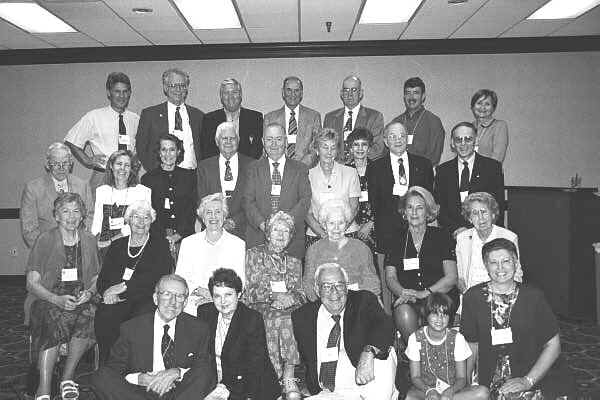
This is the rogues gallery of those who attended the Louisville meeting. I’ll identify them by rows.
First row, left to right:
Mel Underhill, Helen Underhill, George Underhill, Margaux Underhill, Elyse Underhill
Second row, left to right:
Hope Conley, Pat Newman, Edith Uhlendorf, Alice Mitchell, Dorothy Underhill Maxwell, Ann Underhill, Adele Talmage
Third row, left to right:
Del Newman, Beverly Knight, Mary de Marigny, Frank Uhlendorf, Sam Mitchell, Marge Underhill, Jean Underhill, Harold Campbell, Bill Underhill
Fourth row, left to right:
Jeff Underhill, Carl Underhill, Don Underhill, Everett Underhill, Ken Underhill, Hans Hammer, Diane Underhill
Not pictured: Todd Underhill, Colleen Underhill, Jordon Underhill, Channing Underhill
We had a grand time together in Louisville.
We began on Thursday night with cocktails and dinner at the home of
George and Ann Underhill, who were great hosts.
How could we miss, with Ann’s fantastic cooking skills and George’s open bar?
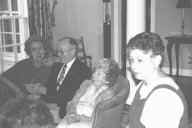 |
From left are Adele Talmage, Harold Campbell, Alice Mitchell, and Elyse Underhill.
|
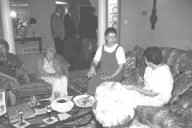 |
The men are plotting in the background, while the women hold court in the foreground. From left are Adele, Alice, Elyse, and Helen Underhill. |
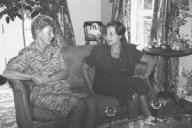 |
This tête-à-tête is between Marge Underhill, left, and Diane Underhill. |
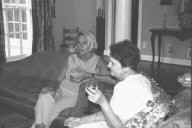 |
Our hostess, Ann Underhill on the left, and Helen Underhill were paying close attention to the conversation of the moment. |
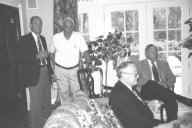 |
The men finally progressed to the foreground. From left are Everett Underhill, George Underhill, Harold Campbell, and Don Underhill. Carl Underhill is somewhere in the house, but he escaped my camera! |
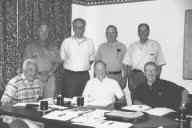 |
On Friday morning we had a board meeting. In back, from left, are Don Underhill, Carl Underhill, Sam Mitchell, and Everett Underhill. At the table are, from left, George Underhill, Harold Campbell, and Mel Underhill. |
|
Top of Page
|
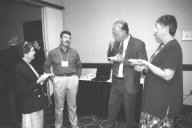 |
We registered in the afternoon. That evening we had a happy hour, where we enjoyed meeting some new faces, followed by the annual meeting.
On the left are, from left, Helen Underhill, Hans Hammer, Carl, and Elyse Underhill enjoying hors d’oeuvres.
|
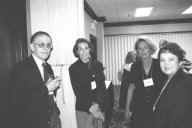 |
From left, Bill Underhill, Mary de Marigny, Ann Underhill, and Helen Underhill. |
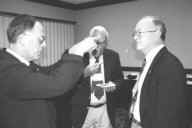 |
Left, Bill Underhill is explaining something to George Underhill and Harold Campbell. George is the one eating! |
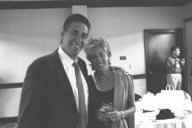 |
Left, Todd, and Colleen Underhill are the son and daughter-in-law of Ann and George Underhill. That’s Hans Hammer in the background. |
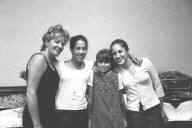 |
This quartet, on the left, was having so much fun I simply had to capture the moment! From left, Colleen Underhill, daughter Jordon Underhill, niece Margaux Underhill, and daughter Channing Underhill. |
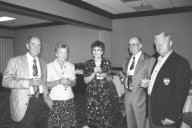 |
Another group of happy hour devotees, from left, Everett Underhill, Marge Underhill, Jean Underhill, Ken Underhill, and Don Underhill. |
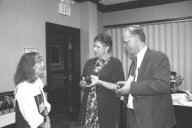 |
From right, Carl and Elyse Underhill greet Beverly Underhill Knight. |
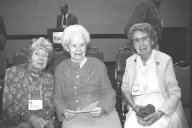 |
From left, Alice Mitchell, Dorothy Underhill Maxwell (George Underhill’s mother), and Adele Talmage enjoy a pre-dinner chat. |
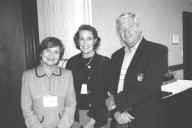 |
Mary de Marigny got pictured again with Diane Underhill, left, and Don Underhill, the Texas trio. |
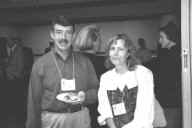 |
Hans Hammer and Beverly Underhill Knight. Hans hails from Atlanta and Beverly lives in Radcliff, Kentucky, not far from Louisville. |
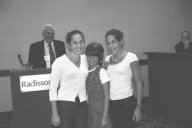 |
Left, George Underhill and Harold Campbell are in the background admiring Channing, Margaux, and Jordon while they took a bow after the reading of some of the winning essays of the Phebe Underhill Smith Essay Contest. |
| You should have been there! |
| Top of Page |
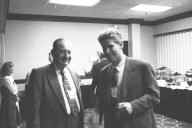 |
Sam Mitchell, left, and Jeff Underhill are discussing current affairs before settling down to the dinner meeting. Jeff is Ann and George’s other son, whose daughter Margaux is pictured on page 2. |
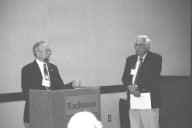 |
Harold Campbell and George Underhill opened the annual meeting. |
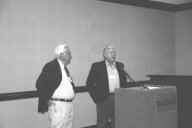 |
George introduced Don Underhill, who reported on the upcoming annual meeting to be held in San Antonio, Texas next year. |
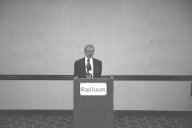 |
Speaking of Mel Underhill, earlier in the meeting I gave a report on our World Wide Web site. As of this writing, December 20, 2000, we have had 5392 visitors to our site since going online on October 1, 1997. |
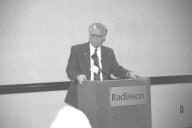 |
Carl Underhill took the lectern to give the genealogist’s report and then presided over the election of officers. |
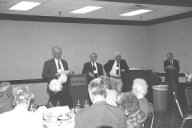 |
The election of officers progressed with Carl on the left, flanked on the right, Carl’s left that is, by Mel Underhill, George and Harold. You can see that Harold is taking it all down. This was close to the adjournment of the meeting. |
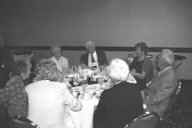 |
Going around the dinner table from the left and facing us, Edith Uhlendorf, Frank Uhlendorf, and Hope Conley are preparing to enjoy the feast. |
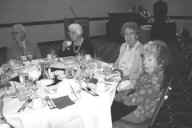 |
Around the same table from left, Del Newman, Pat Newman, Adele Talmage, and Alice Mitchell eagerly await the main course. |
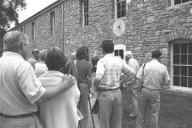 |
We boarded the tour bus Saturday morning and headed out through the Bluegrass countryside. The first stop was the Labrot & Graham Distillery, home of true Kentucky bourbon in Woodford County near Versailles. This place is completely surrounded by beautiful thoroughbred horse farms, with their 4 and 5-board fences drawing patterns on the rolling terrain. After the tour, we were treated to Kentucky bourbon ball chocolate candy and peach tea (really great tea!). |
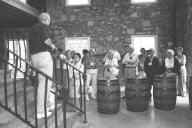 |
We gathered outside of the distillery for the tour. Once inside, our tour guide identified the main ingredients that go into the mix to be distilled. Of course, the exact proportions are a closely guarded secret! Even the tour guide is not apprised of the percentages. |
| Top of Page |
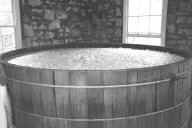 |
The vats were bubbling away with the appropriate ingredients. |
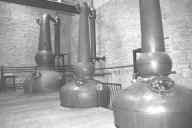 |
This is the only distillery in the country that still uses copper stills! They have always used them, it’s one of their distinctions. As you can see, they are huge. |
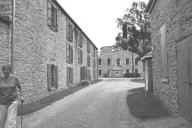 |
That’s Hope Conley trodding between the aging buildings. There are barrels upon barrels of aging bourbon stored in these buildings to be opened in years to come for bottling. |
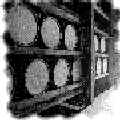 |
We were told that it’s not bourbon unless it’s matured in new charred white oak barrels. The charred inside of the barrel helps bring out the characteristics of the wood which give bourbon its distinctive taste and rich color. We saw a barrel marked for the Governor of Kentucky, and another for the chairman of Brown-Forman Corporation, the parent company. |
| Then we traveled through Harrodsburg to Historic Shaker Village of Pleasant Hill. THIS IS PLEASANT HILL, KENTUCKY, on whose meadows and hills a Shaker colony once existed. You are invited to turn your thoughts for a while to a way of life that prospered, waned, and is no more. Here is the story of a search for the perfect society by a devout and visionary people. |
|
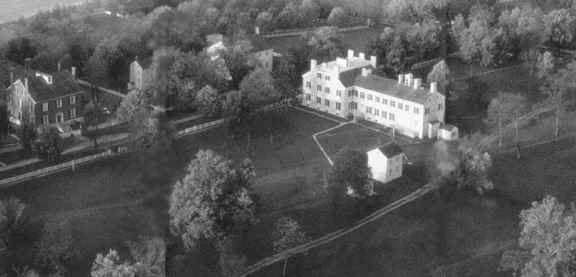
|
|
The Shaker Legacy
The United Society of Believers in Christ’s Second Appearing, known to the world as Shakers because of their ritualistic dance, were nineteenth-century America’s largest and best-known communal society. Their movement began in New York State shortly after the revolution, and by the 1840s, nearly 6000 Shakers lived in communities from Maine to Kentucky.
The Shakers chose a peaceful way of life. They were celibate, believed in equality of race and sex, and freedom from prejudice. A practical and innovative people, they were well known for their labor-saving inventions The best known of these is the flat broom. A quest for simplicity and perfection is reflected in their fine design and craftsmanship and the term "Shaker-made" has become a hallmark of excellence around the world.
The Shakers came to central Kentucky in 1805 and, on a high plateau above the Kentucky River near Harrodsburg, established a village they named Pleasant Hill. Although by the mid-nineteenth century the community was thriving with as many as 500 residents and more than 4000 acres of land, changing social attitudes and the industrial revolution signaled its decline. By 1910, only a few Shakers survived and the village was closed.
For the next 50 years, Pleasant Hill existed as a small farm community, and in 1961, a nonprofit group was formed to preserve its heritage. Since that time, 33 original buildings have been restored and 2700 acres of farmland preserved.
Today the Shaker Village of Pleasant Hill is a model for historic preservation. A National Historic Landmark from boundary to boundary, it is the only site of its kind where all visitor services are provided in original buildings.
Kentucky Shakers no longer exist and only one community is active in New England, yet their lasting influence is a legacy to all who visit Pleasant Hill.
|
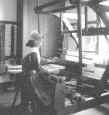 A Shaker woman works at her loom. The village was completely self-sufficient. They made all their own clothing, bedding, linens, and rugs. A Shaker woman works at her loom. The village was completely self-sufficient. They made all their own clothing, bedding, linens, and rugs.
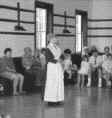
The narrator at right is explaining that men and women were always seated on opposite sides. The candle holders on the walls could be moved anywhere along those rails, on which chairs could also be stored.
|
This device is known as a weasel, used to measure yarn. It would be set at the appropriate length to measure and when that length was achieved, it would pop. Thus was born the phrase "pop goes the weasel!
|
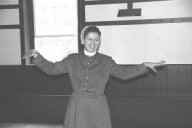 |
This Shaker (our narrator) demonstrates the reason Shakers were known by that name. They would sway and shake their arms during religious services, demonstrating how they were being moved by the Spirit. They were very good singers and wrote most, if not all, of their own songs and hymns. |
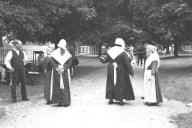 |
Some Shakers were gathered in the street, in front of the Meeting Hall. |
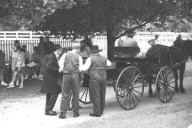 |
Enactment of the funeral and burial of a dearly departed member of their flock was conducted while we were in the village. On the left, the sister’s casket was loaded onto a wagon following the funeral in the Meeting Hall. |
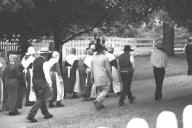 |
Then the villagers accompanied the wagon to the cemetery for the burial. |
| Top of Page |
The Kentucky History Center, in Frankfort, was our next stop. The Kentucky Historical Society has ensured that Kentucky history can he enjoyed for lifetimes to come by constructing the Kentucky History Center. The Kentucky History Center is a classically inspired contemporary building of 167,000 square feet, designed to house the state museum as well as the research library, the educational programs, the special events, and the publications programs of the Kentucky Historical Society. A 25,000-square-foot permanent exhibit gallery and a 5,000-square-foot changing exhibit gallery flank the atrium. The permanent exhibit is divided into ten distinct areas, each representing a specific period of time in Kentucky’s hi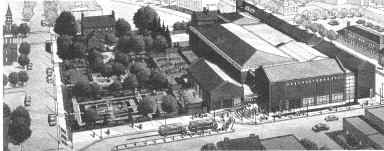 story. The changing exhibit will house temporary exhibits showcasing local artifacts, as well as traveling exhibits from world-renowned history and art museums such as the Smithsonian. story. The changing exhibit will house temporary exhibits showcasing local artifacts, as well as traveling exhibits from world-renowned history and art museums such as the Smithsonian.
I don’t know what happened to my picture-taking duties during our tour of the Kentucky History Center, but I cannot locate any photos of that part of our tour. I must of been between rolls and didn’t take the time to reload. We arrived late in the afternoon and the Center closed at 5:00 PM, so we hurried through to see as much as we could. We saw some original tools used by craftsmen of the early Kentucky years, some of which are donated by George and Ann Underhill. There was even a full-size river raft on display as a walk-through venue, complete with a cabin on the deck. Helen and I will have to revisit the Center and perhaps give a more detailed report in a later newsletter.
|
|
Then on to dinner at the Old Stone Inn in Simpsonville, 8 miles west of Shelbyville on Highway 60. In the early 1800s, when Highway 60 was called the Lexington and Louisville Turnpike, the Old Stone Inn, circa 1805, was well known as a hospitable stagecoach inn and tavern. New proprietors have restored the inn as a restaurant and gift shop. The food is rich and pure Southern, so come hungry when the old dinner bell rings.
Originally built as a residence when Simpsonville was part of Jefferson County, Virginia. The inn was constructed with limestone walls an average of 21 inches thick. Licensed as a tavern and operated as a stagecoach stop from 1826 to 1924. In 1924, "Ye Olde Stone Inn" opened as a restaurant and bed and breakfast.
|
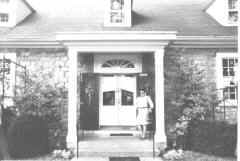 |
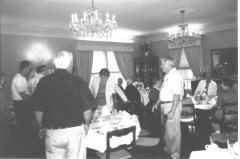 |
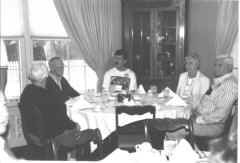 |
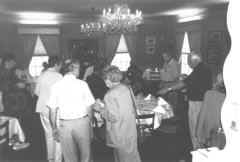 |
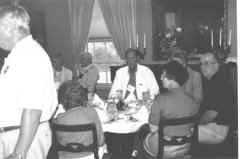 |
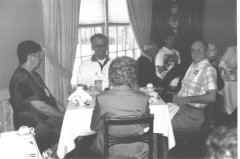 |
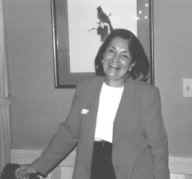 |
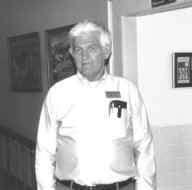 |
At the top left, Helen Underhill poses at the entrance of Old Stone Inn. You can recognize others in the dining room as they await the dinner that the good smells from the kitchen promise.
The smiling lady at the left was our tour guide and the gentleman to the right was our bus driver. A very congenial pair to spend the day with.
|

